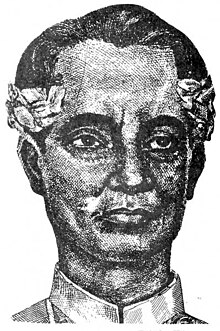Francisco Balagtas
Francisco Balagtas (* 2. April 1788 in Panginay , Viceroyalty of New Spain ; † 20th February 1862 ) was a poet and writer , who at the time to Spain belonging Philippines lived. He is one of the most important authors of the Tagalog .
biography
After attending the Bigaa community school, he worked as a house boy with a family in Tondo , which enabled him to study technology , philosophy , human sciences and canon law at the Colegio de San José . One of his teachers, José de la Cruz , later became the mentor of his writing.
His first poems were influenced by Manuel de la Cruz, called Huseng Sisiw , one of the most famous poets from Tondo and who personally inspired him to write poems. He wrote his poetry in Tagalog during a time when Filipino literature was mainly written in Spanish .
In 1835 he settled in Pandacan and met María Celia Asunción Rivera there, who became the muse of his later works and who appeared as the characters "Cecilio" and "MAR" in his literary masterpiece Florante at Laura .
However, Balagtas lost his efforts for Celia's love against the influential Mariano Capule, who used his wealth to arrest Balagtas on the accusation that he had ordered a servant's hair to be cut. This incident was also the basis for Florante at Laura , which was published in 1838 after his release from prison .
In 1840 he moved to Balanga in Bataan , where he worked as an assistant to the local justice of the peace . In 1856 he became a major lieutenant as well as an interpreter at court hearings.
Balagtas later became the "father of Balagtasan" ( Ama ng Balagtasan ), a debate named after him in the form of a poem , in which the same characters often appear as the narrator ( Tagapagsalaysay ), the gentleman ( Lakandiwa ) and the lady ( Lakambini ) .
Florante at Laura
The original title of the work is: Pinagdaanang Buhay ni Florante at ni Laura sa Cahariang Albania , in English translation: The Story of Florante and Laura in the Kingdom of Albania . The action takes place in an imagined medieval Albania . Heroes of the book are the Christian Albanian nobleman Florante and his also noble Persian Islamic friend Aladin. In the book, Florante tells of his childhood, his years of study in Athens and the following military ventures; they are contrasted with the corresponding stories of his friend Aladin. The plot does not follow any chronological order, the narrators look back on their lives , similar to Homer . The story consists of 399 quatrains that are sung aloud. The poem is written in Tagalog, to give the text more dignity and meaning, Balagtas sometimes switches to Spanish . Example of a quatrain:
'Paalam Albaniang pinamamayanan ng casama, t, lupit, bangis caliluhan, acong tangulan mo, i, cusa mang pinatay sa iyo, i, mala qui ang panghihinayang.'
"'Farewell, Albania ,. kingdom now of evil, cruelty, brutishness and deceit! I, your defender, whom you · now murder Nevertheless lament the fate that has befallen you. ' ( en ) "
Other works
Balagtas, who is referred to as William Shakespeare des Tagalog, wrote numerous other works in addition to Florante at Laura . These include:
- Orosmán at Zafira , comedy in four parts
- Don Nuño at Selinda , comedy in three parts
- Auredato at Astrome , comedy in three parts
- Clara Belmore , comedy in three parts
- Abdol at Misereanan , Comedy (first performed in Abucay , 1857)
- Bayaceto at Dorslica , comedy in three parts (first performance in Udyong, September 27, 1857)
- Alamansor at Rosalinda , Comedy (World premiere at the city festival of Udyong)
- La India elegant y el negrito amante , one-act play
- Nudo gordeano
- Rodolfo at Rosemonda
- Mahomet at Constanza
- Claus , translation from Latin
Honors
His hometown Bigaa was later renamed Balagtas in his honor. In Manila, the Francisco Balagtas Elementary School (FBES) on Alvarez Street in Santa Cruz, Manila, was named in his honor. In Pandacan there is also the Balagtas Park and the Balagtas Plaza, in the vicinity of which the streets are named after characters from Florante at Laura .
Individual evidence
- ↑ a b Imagined Communities. Reflections on the Origin and Spread of Nationalism , Benedict Anderson , Verso, London New York 2006, ISBN 978-1-84467-086-4 , pp. 28 f.
| personal data | |
|---|---|
| SURNAME | Balagtas, Francisco |
| ALTERNATIVE NAMES | Francisco de a Cruz Baltazar (maiden name) |
| BRIEF DESCRIPTION | Tagali poet and writer |
| DATE OF BIRTH | April 2, 1788 |
| PLACE OF BIRTH | Panginay, Bigaa |
| DATE OF DEATH | February 20, 1862 |
